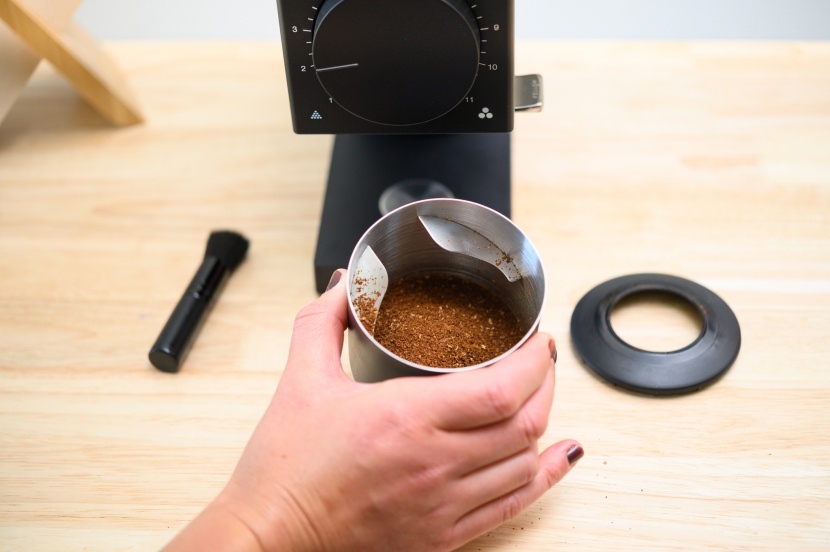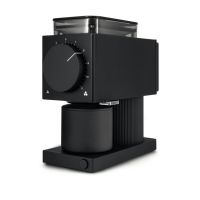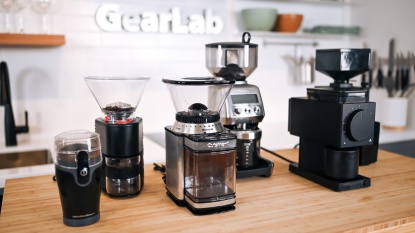Fellow Ode Review

Our Verdict
Our Analysis and Test Results
Above all else, the Fellow Ode provides a beautiful modern design unlike any other burr grinder on today's market. Not only does it offer a minimal footprint, but it is also compact enough to fit under almost any kitchen cabinet or on any coffee bar.
Grind Consistency
Unfortunately, our coffee team discovered that the Ode produces an overall inconsistent grind quality. In our analysis, it took several cups to dial in a standard pour-over setting.
We ground 21 grams of coffee at the recommended setting for pour-over and then ran the grounds through a series of sieves to analyze the distribution of grind sizes in the sample. Only 51% of the grounds fell into the perfect pour-over range in these sieve tests. The other 49% either fell into the extreme fine or coarse end of the spectrum — coffee ground too fine will result in an over-extraction, longer brew times, and harsh flavors. In contrast, overly coarse grounds will under-extract, taste weak, and brew too quickly.
We made three consecutive pour-overs with the coffee ground in the Ode to measure inconsistencies in brew times and found an average of 30-second variations between each cup. For someone who has their pour-over recipe dialed to a three-minute brew time, 30 seconds is a significant variation and reflects in your cup's quality.
A fun piece of the unique design of the Ode is a grind-size guide mapped out on the underside of the hopper lid. In the guide, Fellow provides a visual representation of their grind settings in correlation to different brew methods. The chart displays the grind dial overlapping with suggested brew ranges, with pour-over on the fine end and French press on the coarse side. Please note, the grind dial goes all the way to 11. “It's very special, you see…” (yes, that's a Spinal Tap reference).
However, in our experience, this guide leans heavier to the coarse side. Coarser grounds are acceptable for dark roasted coffees, but you need finer adjustments to bring out the desired complexities of light roasted coffee. And as the manual states, the Ode does not produce an espresso grind.
Cleanliness
Overall, static proved to be a significant problem with the Ode. The heavy static the machine produces allows coffee to stick to the grinding chute and catch bin requiring aggressive flicking to release. There's a knocker feature that is a great design touch but does not do a great job of expelling grounds from the chute. However, Fellow provides a brush for quick clean-up, and for the right person, the design aesthetics of the Ode may outweigh the inconvenience of its messes.
As we stated, the Ode comes with a grind knocker attached to the end of the grinding chute. The knocker is a lever designed to eject chaff and grounds from the chute. This feature is a clever idea, but the Ode produced so much static that coffee and chaff still stuck to the chute, even with some hardcore knocking.
The grounds bin is designed with two fins on the inside, resembling something of a spout. The job of the fins is to guide coffee neatly from the catch and to your brewer. However, the reality is the static created in the metal catch bin clings onto the grounds instead of neatly dispensing them. As a result, grounds stick to the catch and chute enough to recommend weighing your coffee twice.
Overall, the Ode is simple to clean and comes with its own cleaning brush. The brush is excellent for spilled grounds and also very effective for cleaning the burrs. Maintenance is straightforward; the faceplate comes off by hand, and you can then access the burrs by removing four screws (with your own Philips screwdriver). Press to release the auger key, and you have access to cleaning the front and back flat burrs. The burrs are indeed flat instead of the conical burrs standard in every other burr grinder in our testing.
Ease of Use
The Ode has a user-friendly interface. The most prominent feature of the slick design is the large stepped dial with preset notches, allowing you to switch between grind levels easily.
Fellow does not offer programable dosing with the Ode by timer or weight. However, our favorite part of the design is that the hopper holds only enough coffee for a single batch (up to 80g). For real coffee enthusiasts and minimalists alike, a small hopper is clutch. Proper storage of coffee is essential to the freshness of your brew. Coffee is light and moisture-sensitive, so even a rainy day could affect your beans. Ideal storage is an airtight and light-sensitive container, not sitting around in a clear hopper.
Another neat user-friendly detail of the Fellow Ode is the magnetic lock feature, meant to hold the catch bin in place while grinding. With magnets on both the grinder base and the catch bin itself, coffee drops straight into the perfectly aligned catch.
It is helpful to know that the lid of the catch bin is easy to put on crooked, preventing the bin from clicking in place correctly.
Noise
If you want to wow your housemates with a grinder that is a statement piece and a friendly machine unlikely to wake them in the morning, the Ode is our top pick. It took first place in our testing for the least offensive sounding grinder at 84.1 decibels.
The Ode stands out with a quiet, almost purr-like hum during operation. Also, this grinder is really fast, with a grind time lasting half as long as other models.
The Ode comes equipped with PID feedback control, allowing the motor to shut off automatically when particles are no longer detected between the burrs. Auto shutoff is a fantastic feature if you're someone who likes to heat up the kettle or rinse your filter while your coffee grinds. And with sleeping housemates, you don't have to worry about your grinder running longer than it needs to.
Value
The Ode is priced as a top-shelf grinder, yet some key aspects of its performance are only mediocre. There are many burr grinders on the market that can perform just as well or better for less money.
Conclusion
The Fellow Ode is our recommendation if you're on the hunt for a quiet grinder with nice features. Unfortunately, it looks better than it performs; an average burr grinder with an above-average cost makes this model a reasonably uncompelling choice for most consumers. However, if you value aesthetics above all else and only need to grind for brewed coffee (no espresso), the Ode takes the cake.
| Awards | |
|---|---|
| Price | $350 List Check Price at Amazon |
Overall Score  |
|
| Star Rating | |
| Bottom Line | Ideal for those that value aesthetics and minimal sound, but the grind consistency was unfortunately subpar |
| Pros | Quiet, modern design, user-friendly |
| Cons | Expensive, inconsistent grind quality, messy |
| Rating Categories | Fellow Ode |
| Grind Consistency (35%) | |
| Cleanliness (25%) | |
| Ease of Use (25%) | |
| Noise (15%) | |
| Specifications | Fellow Ode |
| Grinding Mechanism | Flat burr |
| Burr/Blade Material | Stainless steel |
| Dosing Mechanism | Manual |
| Best Brew Application | Pour over |
| Dimensions | 9.4″ x 4.2″ x 9.5″ |
| Weight | 9.9 lbs |
| Cup Material | Metal |
| Warranty | One year limited |
















